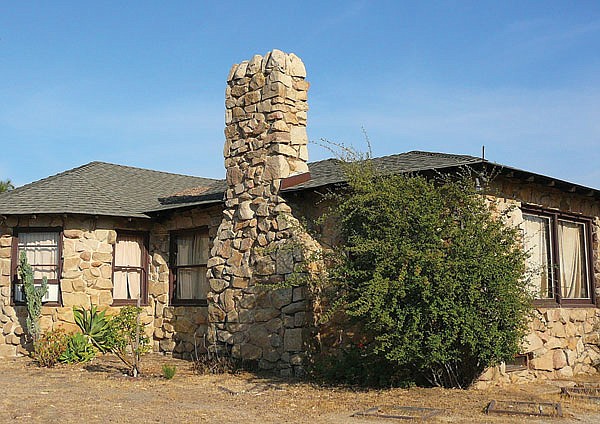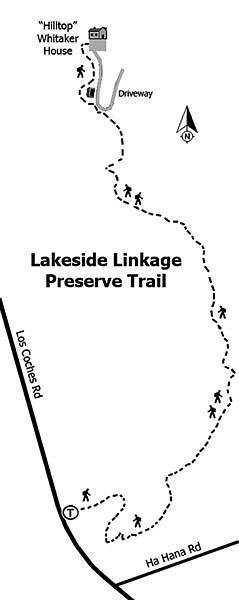 Facebook
Facebook
 X
X
 Instagram
Instagram
 TikTok
TikTok
 Youtube
Youtube

Begin the hike to the Whitaker house from the trailhead on Los Coches Road that is well signed, describing the preserve as a coastal sage scrub habitat. This type of habitat is native to the coastal and inland hillsides of Southern California and is considered endangered. Only 15 percent of it is left because of urban development. It is home to endangered species like the California gnatcatcher and the coastal horned lizard. The gnatcatcher is a small gray bird with a call similar to a kitten’s cry. The gnatcatcher depends on the coastal sage scrub habitat to feed, mate, and reproduce. Other sensitive species in this habitat include the coastal cactus wren and the orange-throated whiptail.
The first quarter of a mile winds up the ridge and then follows it to the north. Common plants on this hike include chamise, buckwheat, chaparral broom, laurel sumac, and California sagebrush. The trail joins a dirt road for one small section and then breaks off to the left. The trail skirts several houses that were built along the ridge in years past. There are many viewpoints along the ridge hike, but the best views are at the Whitaker house. At mile 1.29, the trail appears to end at the steep paved road leading up to the Whitaker house, which can be seen above. However, the trail does continue to the left, around the property leading to stone steps up to the driveway area. Several benches are located around the house to sit and rest. Visible from the top are Lindo Lake and El Capitan. Follow the same route to return to the trailhead.

Nationally known master architect Mary Jane Coulter (1869–1958), who designed and constructed buildings for the Harvey House in Grand Canyon National Park, inspired the design of the “Hilltop” house in what is known as National Park Service rustic style. The Whitakers built the stone house over a five-year period from 1935–1940. They used stones found on the property. The rocks were broken into building blocks by Hale Whitaker, who used a sledgehammer to expose millions of years of crystallization and petrified moss faces. The house is surrounded by trees and shrubs originally planted by Mildred Whitaker. The Whitakers and Mildred’s mother are buried on the property. The county has a caretaker who lives in a trailer on the premises. The hilltop area is open seven days a week from dawn to dusk. The house is open for public viewing only on special occasions.

Hale and Mildred Whitaker donated their 7.5-acre hilltop and 1500-square foot stone home to the county in 1992 so “that it never be broken or cut up, but it be recognized as God’s Hill” for all to enjoy. It was a donation that created a problem for the county. The only road to the property was a single-track steeply paved road to the top that was unsafe to open to the public. For years, the property languished. In 2008, the county designated it as a historic site, allowing improvements and then designating adjoining open space areas as a preserve under the Multiple Species Conservation Program. The Lakeside Linkage Open Space Preserve is 100 acres in size and has a trail that now “links” to the historic site, making it available to hikers.
Distance from downtown San Diego: 23 miles. Allow 27 minutes. Take CA-163N and merge onto I-8E toward El Centro. Drive 17.5 miles and exit left (north) on Los Coches Road. Drive 1.4 miles and park on street, past Ha Hana and just before Los Coches Ct. The trailhead signs are on the right (east). No facilities. Dogs allowed on a leash.
Hiking length: 2.8 miles round trip.
Difficulty: Moderate because of total elevation gain of 732 feet. This is a ridge climb. Trekking poles are recommended. Carry water.


Begin the hike to the Whitaker house from the trailhead on Los Coches Road that is well signed, describing the preserve as a coastal sage scrub habitat. This type of habitat is native to the coastal and inland hillsides of Southern California and is considered endangered. Only 15 percent of it is left because of urban development. It is home to endangered species like the California gnatcatcher and the coastal horned lizard. The gnatcatcher is a small gray bird with a call similar to a kitten’s cry. The gnatcatcher depends on the coastal sage scrub habitat to feed, mate, and reproduce. Other sensitive species in this habitat include the coastal cactus wren and the orange-throated whiptail.
The first quarter of a mile winds up the ridge and then follows it to the north. Common plants on this hike include chamise, buckwheat, chaparral broom, laurel sumac, and California sagebrush. The trail joins a dirt road for one small section and then breaks off to the left. The trail skirts several houses that were built along the ridge in years past. There are many viewpoints along the ridge hike, but the best views are at the Whitaker house. At mile 1.29, the trail appears to end at the steep paved road leading up to the Whitaker house, which can be seen above. However, the trail does continue to the left, around the property leading to stone steps up to the driveway area. Several benches are located around the house to sit and rest. Visible from the top are Lindo Lake and El Capitan. Follow the same route to return to the trailhead.

Nationally known master architect Mary Jane Coulter (1869–1958), who designed and constructed buildings for the Harvey House in Grand Canyon National Park, inspired the design of the “Hilltop” house in what is known as National Park Service rustic style. The Whitakers built the stone house over a five-year period from 1935–1940. They used stones found on the property. The rocks were broken into building blocks by Hale Whitaker, who used a sledgehammer to expose millions of years of crystallization and petrified moss faces. The house is surrounded by trees and shrubs originally planted by Mildred Whitaker. The Whitakers and Mildred’s mother are buried on the property. The county has a caretaker who lives in a trailer on the premises. The hilltop area is open seven days a week from dawn to dusk. The house is open for public viewing only on special occasions.

Hale and Mildred Whitaker donated their 7.5-acre hilltop and 1500-square foot stone home to the county in 1992 so “that it never be broken or cut up, but it be recognized as God’s Hill” for all to enjoy. It was a donation that created a problem for the county. The only road to the property was a single-track steeply paved road to the top that was unsafe to open to the public. For years, the property languished. In 2008, the county designated it as a historic site, allowing improvements and then designating adjoining open space areas as a preserve under the Multiple Species Conservation Program. The Lakeside Linkage Open Space Preserve is 100 acres in size and has a trail that now “links” to the historic site, making it available to hikers.
Distance from downtown San Diego: 23 miles. Allow 27 minutes. Take CA-163N and merge onto I-8E toward El Centro. Drive 17.5 miles and exit left (north) on Los Coches Road. Drive 1.4 miles and park on street, past Ha Hana and just before Los Coches Ct. The trailhead signs are on the right (east). No facilities. Dogs allowed on a leash.
Hiking length: 2.8 miles round trip.
Difficulty: Moderate because of total elevation gain of 732 feet. This is a ridge climb. Trekking poles are recommended. Carry water.
Comments